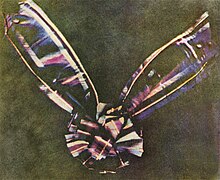
Back تصوير ضوئي ملون Arabic Fotografia en color Catalan Barevná fotografie Czech Farbfotografie German Kolorfotografio Esperanto Fotografía en color Spanish عکاسی رنگی Persian Photographie couleur French Grianghrafadóireacht dhaite Irish צילום בצבע HE
This article has multiple issues. Please help improve it or discuss these issues on the talk page. (Learn how and when to remove these messages)
|

Color photography (also spelled as colour photography in Commonwealth English) is photography that uses media capable of capturing and reproducing colors. By contrast, black-and-white or gray-monochrome photography records only a single channel of luminance (brightness) and uses media capable only of showing shades of gray.
In color photography, electronic sensors or light-sensitive chemicals record color information at the time of exposure. This is usually done by analyzing the spectrum of colors into three channels of information, one dominated by red, another by green and the third by blue, in imitation of the way the normal human eye senses color. The recorded information is then used to reproduce the original colors by mixing various proportions of red, green and blue light (RGB color, used by video displays, digital projectors and some historical photographic processes), or by using dyes or pigments to remove various proportions of the red, green and blue which are present in white light (CMY color, used for prints on paper and transparencies on film).
Monochrome images which have been "colorized" by tinting selected areas by hand or mechanically or with the aid of a computer are "colored photographs", not "color photographs". Their colors are not dependent on the actual colors of the objects photographed and may be inaccurate.
The foundation of all practical color processes, the three-color method was first suggested in an 1855 paper by Scottish physicist James Clerk Maxwell, with the first color photograph produced by Thomas Sutton for a Maxwell lecture in 1861.[1][2] Color photography has been the dominant form of photography since the 1970s, with monochrome photography mostly relegated to niche markets such as fine art photography.
- ^ "1861: James Clerk Maxwell's greatest year". King's College London. 3 January 2017. Archived from the original on 4 January 2017. Retrieved 3 January 2017.
- ^ Cite error: The named reference
Maxwellwas invoked but never defined (see the help page).